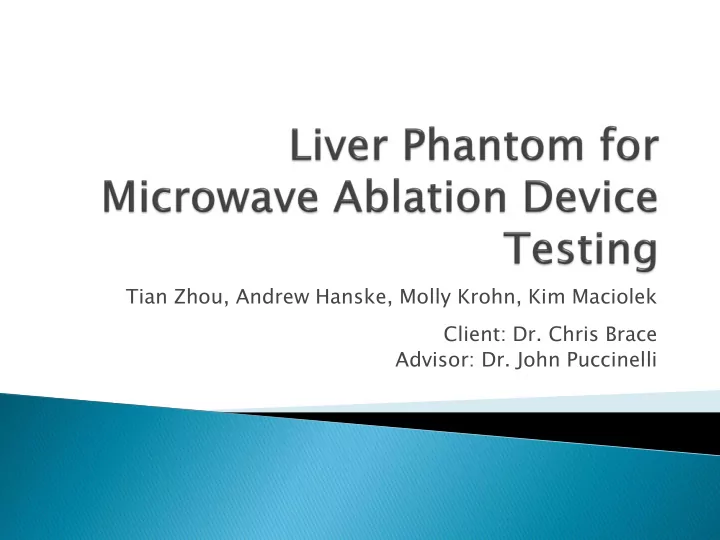

Tian Zhou, Andrew Hanske, Molly Krohn, Kim Maciolek Client: Dr. Chris Brace Advisor: Dr. John Puccinelli
Background Problem Statement Client Requirements Liver Properties Current Testing Methods Current Design ◦ Base Gel Information ◦ Indicator Information Final Design Alternative Design Future Work Acknowledgements Bibliography
Treatment for many abdominal cancers Kills tumor cells by rapidly heating Many advantages compared to other medical treatments 1 Phantom needed to test Figure 1: Microwave ablation procedure 2
Design a phantom liver to test microwave ablation devices Requirements: ◦ Reproducible ◦ Homogenous ◦ Ideally transparent ◦ Indicates Ablation Zone ◦ Cost effective ◦ Similar to liver
Dielectric Constant: 43.3 Electrical Conductivity: 1.68 S/m Wavelength: 1.8 cm Thermal Conductivity: 0.564 W/m · K Density: 1,050 kg/m 3 Perfusion Rate: 1,000 mL/min · kg
Liver tissues 3 Figure 2: ablation zones in liver tissue 9 Polyacrylamide hydrogel with BSA 5,6,7 Figure 3: ablation zones in PAG 7
Figure 5: Sodium Alginate 11 Figure 4: Dielectric Silicone Gel 10 Figure 7: Polyacrylamide Figure 6: Polyvinyl Alcohol (PVA) 12 Gel 13
Dielectric ctric Polyvin inyl l Sodium Polyacr cryl yl- Weight ght Design ign Aspect cts Silicon n Ge Gel Al Alcoho hol Al Alginate nate amide Ge Gel 0.2 Melting Point 8 10 9 4 0.2 Transparency 9 8 0 5 Dielectric 0.2 10 6 5 10 Properties 0.15 Cost 4 8 8 5 0.05 Safety 9 9 8 3 0.05 Shelf Life 8 4 4 6 Assembly 0.15 8 7 7 4 Simplicity 1 - 8.05 7.7 5.65 5.6 Table le 1: Ba Base Gel D l Desig ign n Matrix ix
Thermochromic Dyes (color change in response to temperature 14 ) Permanent Reversible Advantage: Advantage: Disadvantage: Disadvantage: Cheaper Reversible Very sensitive Extremely substitute for color change to expensive albumin allows long environment ($12,500) protein term use Table 2: Comparison of Thermochromic Dyes
Protein Indicators Albumin Ovalbumin (Bovine Hormone) (Egg Whites) Advantage: Denatures at Disadvantage: Advantage: Disadvantage: 50 o C; Relatively Denatures Cheap; Easy to around 80 o C successfully expensive test implemented Table 3: Comparison of Protein Indicators
Albumin Ovalbumin Rever ersib sible e One Time Weight Design n Aspec ects ts (Bovine e (Egg Thermochromic Use Dye Protei tein) White) e) Dye - Reversible No No No Yes .20 Accuracy 10 6 8 8 .20 Cost 3 9 7 1 .10 Preparation 9 7 9 9 .25 Effectiveness 10 10 7 7 Dielectric .15 8 8 3 3 Properties .05 Safety 10 10 6 6 .05 Shelf Life 7 7 10 10 1 - 8.05 8.25 6.9 5.3 Table le 4: In Indic icato tors s Desig ign n Matrix ix
Base gel: Dow Corning Dielectric Silicon Gel Indicator: Ovalbumin (Egg White) Figure 8: Silicon Gel Sheet 14 Figure 9: Eggs (i.e. ovalbumin protein) 15
Thermal Camera ◦ Advantages readily available reusable ◦ Disadvantages Limited by detection depth Expensive (up to $5000) Figure 10: Nikon Infrared Thermal Camera 16
Test current design for: ◦ Accuracy and effectiveness ◦ Dielectric properties ◦ Shelf Life and waste Possible alternatives: ◦ HallCrest Thermochromic Permanent Dye ◦ Whey Protein ◦ Polyvinyl Alcohol Continue research
We would like to extend our thanks to: ◦ Advisor: Prof. John Puccinelli ◦ Client: Dr. Chris Brace
1 Lubner, M.G., Brace, C. L., Hinshaw, J. L. & Lee, Fred T. (2010). Microwave Tumor Ablation: Mechanism of Action, Clinical Results and Devices. Journal of Vascular and Interventional Radiology, 21(8), S192-S203, DOI: 10.1016/j.jvir. 2010.-4.007. 2 Johns Hopkins Medicine. http://www.hopkinsmedicine.org/liver_tumor_center/treatments/ablative_ techniques/radio_frequency _ablation.html 3 Brace C. L. "Temperature-dependent dielectric properties of liver tissue measured during thermal ablation: toward an improved numerical model,". Conf. Proc. IEEE Eng. Med. Biol. Soc. 2008;2008:230 – 3 4 Stauffer, P. R., Rossetto, F., Prakash, M., Neuman, D. G., & Lee, T. (2003). Phantom and animal tissues for modeling the electrical properties of human liver. International Journal of Hyperthermia,19(1), 89-101. 5 Lafon, C., Zderic, V., Noble, M. L., Yuen, J. C., Kaczkowski, P. J., Sapozhnikov, O. A., et al. (2005). Gel phantom for use in high-intensity focused ultrasound dosimetry. Ultrasound in Medicine & Biology, 31(10), 1383-1389. 6 Bouchard, S. & Bronskill, M. J (2000). Magnetic resonance imaging of thermal coagulation effects in a phantom for calibrating thermal therapy devices. Med. Phys. 27, 1141, DOI: 10.1118/1.598980. 7 Zhang, B., Bing, H., Kuang, S., Ying, H. & Wu, Rong., et al. (2008). A polyacrylamide gel phantom for radiofrequency ablation. International Journal of Hyperthermia 24:7, 568-476. 8 Lazebnik, M., Madsen, E. L., Frank, G. R. & Hagness, S. C. (2005). Tissue-mimicking phantom materials for narrowband and ultrawideband microwave applications. Med. Phys. 20 4245, DOI 146.151.19.194. 9 Engineering and Physical Sciences Council. “Microwaving Tumors.” http://www.epsrc.ac.uk/newsevents/ casestudies/beyondbrunel/newengineering/Pages/microwavingtumours.aspx. 10 Silicone Gel Sheet. http://www.made-in-china.com/showroom/wanhe-victoria/product- detailSevQqDUCfnhN/China-Silicone-Gel-Sheet.html. 11 American Society for Testing and Materials. “Regenerative Medicine: Tissue Engineering Standards Come to ASTM.” http://www.astm.org/SNEWS/SEPTEMBER_2000/sept_te.html 12 “Wound Exudate .” http://www.inventivecomputing.com/wound_exudate.html. 13 Shabahashi et al. (1987). Thermochromic Textile Material. Patent 4,681,791. 14 Recova Post Surgery. http://www.recovapostsurgery.com/Scar_Treatment/Silicone_Gel_Sheet_10x10_cm/. 15 Clay’s Kitchen. http://www.panix.com/~clay/cookbook/bin/show_ingredient.cgi?egg. 16 “Nikon Radiometric Camera.” http ://www.imaging1.com/thermal/Nikon_Radiometric.html
Recommend
More recommend